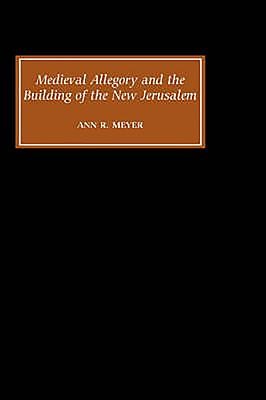
- We will send in 10–14 business days.
- Author: Ann R Meyer
- Publisher: Boydell & Brewer
- ISBN-10: 0859917967
- ISBN-13: 9780859917964
- Format: 15.2 x 24.9 x 2 cm, hardcover
- Language: English
- SAVE -10% with code: EXTRA
Medieval Allegory and the Building of the New Jerusalem (e-book) (used book) | bookbook.eu
Reviews
Description
The concept of the New Jerusalem, the City of God, as realised in architecture and literature, especially Pearl.
This book investigates the concept of the New Jerusalem, the City of God, as an architectural ideal during the middle ages, and the way in which it is represented allegorically in patristic writings, liturgy, building, and later literature. The author begins by examining its conceptual foundations in such sources as the Hebrew Bible, Bede's exegesis, the religious philosophy of Plotinus, and Augustine's theology. She then explores the influence and the expression of the New Jerusalem in liturgy and architecture, using the twelfth-century remodelling of the Abbey Church of St-Denis and its dedication liturgy to show how the building serves as an eschatological and apocalyptic landscape. The chantry movement in late medieval England is situated in this context, and leads to a demonstration of the movement's associations with the highly-wrought poem Pearl and its companion poems; the book analyses Pearl as medieval architecture, offering fresh perspectives on its elaborate construction and historical context. ANN R. MEYER teaches in the Department of Literature, Claremont McKenna College.EXTRA 10 % discount with code: EXTRA
The promotion ends in 18d.20:09:04
The discount code is valid when purchasing from 10 €. Discounts do not stack.
- Author: Ann R Meyer
- Publisher: Boydell & Brewer
- ISBN-10: 0859917967
- ISBN-13: 9780859917964
- Format: 15.2 x 24.9 x 2 cm, hardcover
- Language: English English
The concept of the New Jerusalem, the City of God, as realised in architecture and literature, especially Pearl.
This book investigates the concept of the New Jerusalem, the City of God, as an architectural ideal during the middle ages, and the way in which it is represented allegorically in patristic writings, liturgy, building, and later literature. The author begins by examining its conceptual foundations in such sources as the Hebrew Bible, Bede's exegesis, the religious philosophy of Plotinus, and Augustine's theology. She then explores the influence and the expression of the New Jerusalem in liturgy and architecture, using the twelfth-century remodelling of the Abbey Church of St-Denis and its dedication liturgy to show how the building serves as an eschatological and apocalyptic landscape. The chantry movement in late medieval England is situated in this context, and leads to a demonstration of the movement's associations with the highly-wrought poem Pearl and its companion poems; the book analyses Pearl as medieval architecture, offering fresh perspectives on its elaborate construction and historical context. ANN R. MEYER teaches in the Department of Literature, Claremont McKenna College.

Reviews